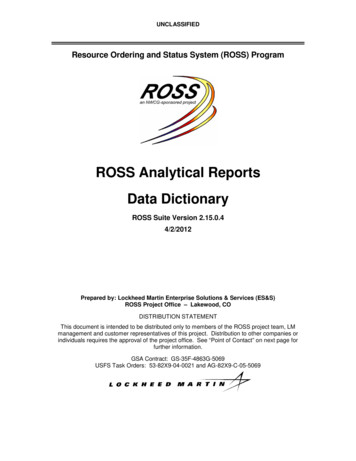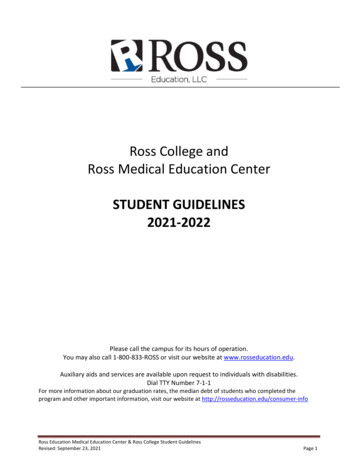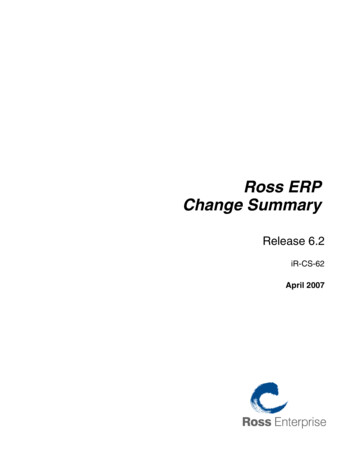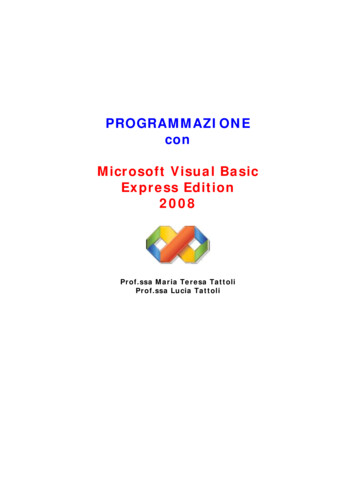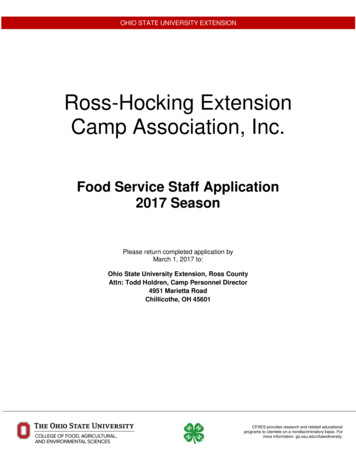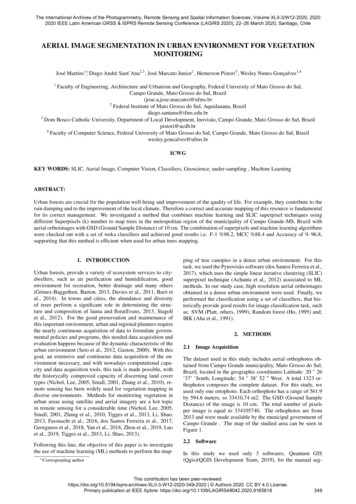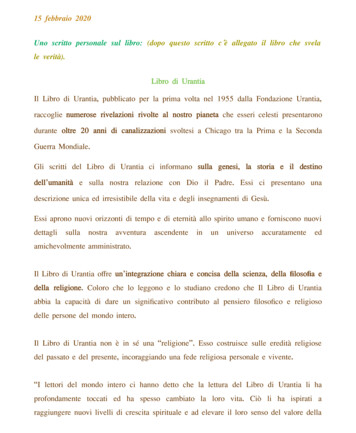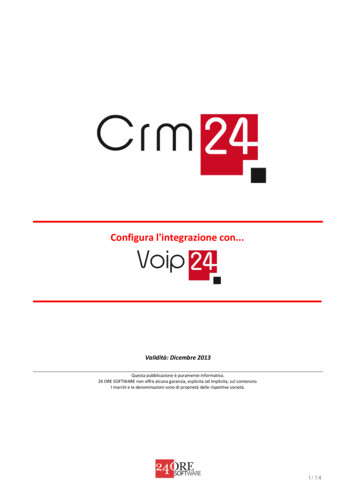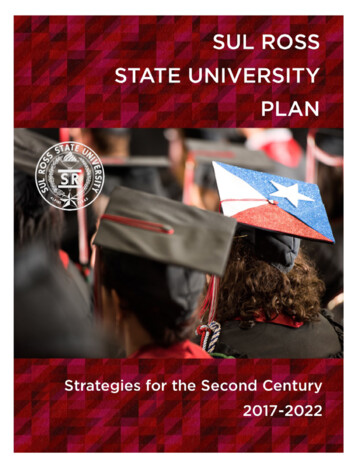
Transcription
To Sul Ross State University Faculty, Staff, Students, and FriendsMindful of the extraordinary milestone of recently celebrating 100years serving the higher education needs of the Big Bend and USMexico border regions of Texas, Sul Ross State University has highaspirations for its future. Those aspirations are reflected in thisnew strategic plan titled “Sul Ross State University Plan: Strategiesfor the Second Century.” This new and dynamic plan was recentlyapproved by the Texas State University System Board of Regents.Photo by Dana JonesImplementation of the multi-year plan is underway, even as somedetails are being finalized.The strategic plan is organized around five goals: Promoting growthin academic, research and artistic excellence; targeting recruiting,maximizing retention and increasing graduation rates;strengthening a sustainable and diversified financial base while ensuring affordable access; recruiting,retaining and developing faculty, staff and student employees; and unifying and enhancing the image andvisibility of Sul Ross. There are 19 objectives and more than 80 strategies that will help guide and measure progress toward the achievement of our goals.The Sul Ross State University Plan was developed over the past year under the leadership of Dr. BonnieWarnock. Planning committees consisting of a Steering Committee and multiple sub-committees representing all aspects of the university developed the strategic plan and the associated assessment plan. Allmembers of the university community had multiple opportunities for review and input.The next page in the plan sets out our vision, mission, and values. Sul Ross does not have to change whowe are. As we enter our second century of serving our students and this unique and distinctive region,we strive to heighten our aspirations and our expectations. Those aspirations and expectations willtranslate into continued and sustained success for our university and our graduates.This Sul Ross State University Plan is intended as a guide for our future. The assessment plan will allowus to monitor our progress and to remain flexible going forward. The strategic plan will be used to guideour decision-making and our work. We remain poised to respond to new opportunities as they come.Sul Ross State University is at an exciting time in our history, entering a new century of service andpoised for a brighter future. Plans themselves do not move us from exciting ideas to bold new realities,but a common understanding of our shared goals will allow us to succeed. I am sincerely grateful to themany individuals who have shaped this ambitious plan, and I look forward to our exciting future.Bill KiblerPresident2Sul Ross State University Plan 2017–2022
Who We AreSul Ross State University is a public, comprehensive, Master’s degree granting, multi-campus university, providingon-site and distance education in the Big Bend and the USMexico border regions of Texas.VisionSul Ross State University seeks to be a national and international leader in achieving excellence among universitiesin the areas of Education, Research, Social Mobility, Service,Affordability, and Shared Governance.MissionRooted in the distinctive surroundings and history of theBig Bend and the US-Mexico border regions of Texas, SulRoss State University provides accessible, comprehensive,and life changing education through high quality teaching,research, cultural awareness, creativity, and service.Values Excellence Ethics and Integrity Diversity and Inclusiveness Growth and Exploration Leadership and Service Personal Connection Effective CommunicationOur Values, Mission and Vision, combined with the challenges outlined in the next section, have guided thisstrategic plan.Sul Ross State University Plan 2017–20223
Who We AreIn 2017, Sul Ross State University (Sul Ross) will begin its Second Century providing a quality postsecondary education as what the US Department of Education classifies a “frontier institution.”Our unique history, which still echoes loudly in our halls, classrooms and athletic fields, makesreaching this milestone that much more notable.Our past has a much larger influence on us than at a typical state university and isreflected in the strategic plan that follows. Appreciating Sul Ross’s place in the TexasState University System, in our local area, and in the lives of our students is essential to understanding this jewel in the desert.Our Place in the Texas StateUniversity SystemSul Ross’s relationship to its governing system, the Texas State University System (TSUS), its sister institutions, and the state has profound implications for this strategic plan.Sul Ross, established in 1917 in Alpine, Texas, was one of thefirst institutions incorporated into what is now the seveninstitution Texas State University System. TSUS wasestablished just a few years earlier (1911) for the fundamental purpose of the training of public schoolteachers. The System still provides a centraladministrative structure for the equally represented component institutions.Today, the Sul Ross student body makesup about 3,000 (4%) of the 84,000 students in the TSUS. This includes approximately 2,000 students at themain Alpine, Texas, campus and1,000 at Sul Ross State University Rio Grande College’sfour campuses that extendacross vast stretches ofthe Middle Rio Granderegion.4Sul Ross State University Plan 2017–2022
Two institutions in the System, Sam Houston State University and Texas State University, account fornearly 70% of total student enrollment.Our Place in the Geography andLocal CommunityMany may wonder how it is that a beautiful, vibrant university in such a remote region of Texas exists,where the largest city of any consequence is a 2½ hour backroad, off-interstate drive away?If not for the town and citizens of Alpine, Sul Ross would not exist. Conversely, if not for Sul Ross,the town of Alpine and surrounding area would not be the vibrant tourist destination that it istoday.That mutual reliance grows out of the nature of the relationship between Texasstate universities and the state legislature discussed in the previous section.In the early 1900s the need for a teacher’s college between the 550-milestretch of arid land betweenSan Antonio and El Paso was based on two facts.First, the area was having trouble attracting teaching candidatesfrom outside. The local school districts had to find a way totransform local talent into teachers. Second, the cost forin-area teachers to travel and stay in San Antonio for recertification was burdensome on a teacher’ssalary.Because Texas colleges rely on specific legislation, local Alpine-area citizens had to maketheir case directly to the legislature tofund the establishment of a teachingcollege in the area. The legislaturemade the location and funding of Sul Ross conditional.Besides donating the land,supplying utilities, andfunding studenthousing, thetown of Alpine hadPhoto by Dana JonesSul Ross State University Plan 2017–20225
to incorporate as a city. So, 1917 marked not onlythe beginning of a university in southwest Texasbut also the establishment of the municipality ofAlpine.In 1923 a local capital campaign of the Chamber ofCommerce and area residents continued to buildon this relationship by funding 41 two-bedroomcottages to address the shortage of suitable studenthousing.The creation of the upper-level Sul Ross StateUniversity Study Center in Uvalde in 1973 (thepredecessor to Sul Ross State University RioGrande College) shows a similar reliance on localcommunity leadership. During the 1960s, multiplestate universities were competing to extend theirofferings into remote areas of Texas via offcampus “extension centers.” At its peak, Sul Rosshad 12 centers, one each in El Paso, Sierra Blanca,Van Horn, Monahans, Midland / Odessa, BigSpring, Snyder, Brownwood, Kerrville, Del Rio,Eagle Pass, and Uvalde.In 1965, the legislature responded to the growing,overlapping offerings by establishing the predecessor to today’s Texas Higher Education Coordinating Board and charging it with rationalizingthese independent efforts. Seizing the opportunity,a contingent of local Middle Rio Grande leaders,including a personal associate of the Governor ofTexas, Dolph Briscoe, approached Sul Ross witha proposal to convert its extension centers in thearea into a permanent relationship with SouthwestTexas Junior College. The fact that Governor Briscoe hailed from Uvalde and had extensive ranching interests in the area put the proposal on firmground. The appointment two years later of Mr.Harry Hornby, publisher of the Uvalde Leader, tothe TSUS Board of Regents, cemented the relation-6Sul Ross State University Plan 2017–2022
ship between SRSU’s Rio Grande College and itssurrounding communities.Next, in 1986, Sul Ross was on the legislature’s“Closure / Merger List.” Hundreds of residents,friends and alumni of Sul Ross appeared at theAustin hearing of the legislature to show support, at which time the college was removedfrom the list.In 1987, Sul Ross was part of a consortium ofborderland universities represented in the LULACv. Richards lawsuit1 that claimed a history of inadequate and inequitable funding, program creationand support.At the time, the border area had 20% of the state’spopulation, but only 10% of the state’s resourcesdedicated to higher education. Furthermore, theaverage mileage to a comprehensive universitywas 225 miles for border-area citizens versus 45miles for the rest of Texas.The LULAC case led to 1993 legislation that substantially increased state funding for under-servedborder-area universities, including Sul Ross. Theleadership of the then Alpine-resident state representative Pete P. Gallego led to appropriations fora new University Center, Early Childhood Development Center, a special events center, a new student housing development, and major renovationsof existing structures.LULAC’s lead attorneys insisted that if Sul Ross wasto be part of the settlement, local community groupsneeded to show unequivocal support for the university, including participating in the design of a remedy and petitioning the legislature even before the1Styled “RICHARDS v. LULAC 868 S.W.2d 306 (1993)” onappealPhoto by Dana JonesSul Ross State University Plan 2017–20227
case was decided.2 Without that visible and unwavering support, Sul Ross would not have the infrastructureit has today. Very possibly, it would have not survived the next encounter with the “Closure / Merger List.”The LULAC case emphasizes the last historical and geographical element that has lasting impact on ourstrategic plan – the student body.Our Place in the Lives of Our StudentsOur heritage just recounted – as a (US Department of Education defined) “frontier institution” tightlybound to its people, its place and its culture – reinforces our mission for the under-served of our borderarea. That mission is reflected in the profile of our 4-year undergraduate cohort at the Alpine campus.Sul Ross State University Rio Grande College (RGC), which represents approximately 1/3 of the university’s3,000 student enrollment, has a different student profile. Housed within the facilities of Southwest TexasJunior College in Uvalde, Del Rio, Eagle Pass and Castroville, it offers upper-level and graduate coursesonly, many delivered using online and web-based instruction. A ‘typical’ RGC student will have more workexperience and family obligations than the typicalAlpine campus student, presenting different graduation and retention challenges. Recognizing thatdifference, this strategic plan incorporates elementsespecially important to the success of RGC.Regardless of campus, Sul Ross students havemodest backgrounds. Many are first-generationstudents. Because of this, Sul Ross has historicallyemphasized affordability. As recently as 2014, it ledPhoto by Dana Jonesthe state in this category and strives to remain in the lower 1/3 of affordability in terms of in-state tuitionand fees of comparable universities.But affordability by itself is of little value absent “mobility,” defined as the portion of a university’s studentswho come from a family in the bottom fifth of the income distribution and end up in the top fifth. In themost recent and exhaustive mobility study, Sul Ross ranked in the top 10% in mobility of the 123 universities studied in Texas.5,62Kauffman, Albert. “Effective Litigation Strategies to Improve State Education and Social Science Systems,” Journal ofLaw & Education, Vol 45, No.43Alpine campus student body4RGC transfer graduation rates dex.html#college6Of the 12 universities that share the top of the list with us, ALL come from the previously defined border area8Sul Ross State University Plan 2017–2022
Upward mobility at Sul Ross comes not only from a quality education, but also from strong, targeted studentsupport services. Studies show that “non-instructional expenditure categories influence graduation andfirst-year persistence rates” and that those services matter more for students with lower entrance scoresand schools that have large number of Pell Grant dollars per student ratios, like Sul Ross.7Examples of these services include cultural events, newspapers, athletics, intramural sports,and student organizations whose “primary purpose is to contribute to student’s emotionaland physical well-being outside of the context of formal instructional programs.”This strategic plan recognizes the role that student services play in success by ensuring continued development of these ata/7index.html#collegeWebber, Douglas A, et al. “Do expen6Of theother12 universitiesthat shareexpendithe topdituresthan instructionaloftheaffectlist withus, ALL andcomefrom erarearates in view, 29Webber, Douglas A, et al. “Do(2010)947-958 other than inexpendituresPhoto courtesy Sul Ross Student Publicationsstructional expendituresaffect graduation andpersistence rates inAmerican higher education?” Economicsof Education Review, 29 (2010)947-958Photo by Dana JonesSul Ross State University Plan 2017–20229
Major Challenges andOur Strategic ResponseRevenueA stable and predictable revenue stream upon which to plan and deliver a quality education is a must.Unfortunately, for the past several years the university has found it necessary to use reserve funds tobalance its operating budget. However increasing enrollments in recent years have contributed to significantly reduced reliance on reserve funds, with the goal of returning to a balanced budget in the nearfuture. This journey back to a balanced budget has brought numerous financial challenges to the university.As an earlier strategic plan stated, “[t]uition revenues, combined with state support, may continue to fallshort of actual per student cost at Sul Ross, despite projected increases in enrollment. The University haslimited authority to raise tuition, and over three-fourths of Sul Ross students receive financial aid.”Goal 3 of this plan, Strengthen a Sustainable & Diversified Financial Base while Ensuring Affordable Access,with its supporting objectives and strategies, is the major area of effort in addressing this challenge.Enrollment, Retention & GraduationAs the profile of our students illustrates, Sul Ross has unique challenges and opportunities regardingenrollment growth and student success.While our students have alternatives other than Sul Ross, our main competition comes from the pull oflow-skill yet lucrative jobs in the nearby West Texas oilfields. And many students’ sense responsibility toforgo or postpone post-secondary schooling in favor of making immediate contributions to the extendedfamily.Even with an intention of continuing on to college, the lure of extremely high-paying jobs in the surrounding oilfields for unskilled, trainable labor can be hard to resist. These countervailing forces may bea persistent call for students throughout their years in college.10Sul Ross State University Plan 2017–2022
The extensive objectives and strategies of Goal #2,Target Recruiting, Maximize Retention & IncreaseGraduation Rates, represent our major undertakings to address this challenge.There are also strategies in Goal #1, PromoteGrowth in Academic, Research and Artistic Excellence, whose secondary and tertiary impact willinfluence our student outcomes.Remote Service AreaSul Ross’ remoteness is both a challenge andan opportunity. As Texas becomes more urban,maintaining in-place educational opportunities forour most remote, under-served citizens becomesmore acute. Outside revenue opportunities areextremely limited as well. Continuing those opportunities will take more creative appeals and asteady, uninterrupted effort, which is made all themore difficult with the state’s unpredictable funding priorities.Nevertheless, the Sul Ross philosophy is that wemeet the challenge of our unique geographiclandscape and remoteness by embracing it. Thisis reflected in this strategic plan. A typical effortshows in Goal #1 Objective #2, Establish ourselvesas a regional leader in providing curricular programs that leverage the educational potential ofour rich and diverse campus community. We alsoembrace it in our programming and associated research from our Center for Big Bend Studies, the RioGrande Research Center, the Borderlands ResearchInstitute, and our unique collections and workshopsof the Museum of the Big Bend.The details of our strategic plan follow.GoalsSul Ross State University Plan 2017–202211
Goal 1: Promote Growth in Academic, Research and Artistic ExcellenceGoal 2: Target Recruiting, Maximize Retention & Increase GraduationRatesGoal 3: Strengthen a Sustainable and Diversified FinancialBase while Ensuring Affordable AccessGoal 4: Recruit, Retain and Develop Faculty,Staff and Student EmployeesGoal 5: Unify and Enhance the Image and Visibility ofSul RossObjectivesGoal 1: Promote Growth in Academic, Research and Artistic ExcellenceObjective 1: Develop new or build on existing learning programs (including distance educationprograms) to create expanded opportunities to “learn by doing” across the curriculum, emphasizing tangible skills for lifelong learning and preparation to contributeto 21st century society.Objective 2: Establish SRSU, as a regional leader in providing curricular programs that leveragethe educational potential of our rich and diverse campus community.Objective 3: Support, improve and recognize research and its impact on faculty developmentand student engagement and learning.Objective 4: Support, improve and recognize excellence in artistic endeavors.Objective 5: Encourage and support efforts to obtain external funding for all forms of activity,including: research, education, scholarly, creative, service and outreach.Goal 2: Target Recruiting, Maximize Retention & Increase Graduation RatesObjective 1: Increase new student enrollment over the next five years.Objective 2: Increase student retention and persistence over the next five years.Objective 3: Increase overall student graduation rates over the next five years.12Sul Ross State University Plan 2017–2022
Goal 3: Strengthen a Sustainable & Diversified Financial Base while Ensuring Affordable AccessObjective 1: Advance available operating resources.Objective 2: Cultivate an appropriate infrastructure of personnel, resources, and facilities thatcan be maintained by available revenue.Objective 3: Support and develop resources that enable the university to cultivate, expand andsustain philanthropic support.Objective 4: Maintain the university’s relative affordability in Texas, while providing a “Privateeducation experience at a state education price.”Goal 4: Recruit, Retain & Develop Faculty, Staff and Student EmployeesObjective 1: Provide competitive salaries, benefits, and professional advancement resources tosupport the recruitment, retention, and development of faculty and staff.Objective 2: Create an environment that promotes development, training and job satisfaction forfaculty, staff and student employees.Goal 5: Unify and Enhance the Image and Visibility of Sul RossObjective 1: Increase awareness of and advocacy for the university by showcasing Sul Ross’steaching, learning, research, athletics and artistic endeavors.Objective 2: Maintain a visually unified, aesthetically pleasing campus that showcases ourstatus of quality and regional leadership in higher education.Objective 3: Advance and provide support for sustainability initiatives throughoutthe university.Objective 4: Broaden and deepen constituent engagement, developingmore meaningful relationships with alumni, friendsand students.Objective 5: Promote athletics through excellence inall sports.Photo by Dana JonesSul Ross State University Plan 2017–202213
StrategiesGoal 1: Promote Growth in Academic, Research and Artistic ExcellenceObjective 1: Develop new or build on existing learning programs (including distance education programs) to create expanded opportunities to “learn by doing” across thecurriculum, emphasizing tangible skills for lifelong learning and preparation tocontribute to 21st century societyStrategy 1: Expand Summer Bridge Programs.Strategy 2: Promote high-quality teaching by establishing a faculty discussion series “Pedagogy and Practice.”Strategy 3: Develop a comprehensive educational career program and a program ofcareer-focused student internships.Strategy 4: Engage and support student applications to national and internationalservice organizations such as Fulbright U.S. Student Program, PeaceCorps, AmeriCorps, etc.Strategy 5: Establish a Task Force within the Office of International Studies todevelop programs that encourage participation in national and international field study and travel programs.Strategy 6: Improve technical support in distance learning to include online/webbased learning and teleconference instruction.Objective 2: Establish SRSU as a regional leader in providing curricular programs that leverage the educational potential of our rich and diverse campus communityStrategy 1: To promote high impact educational experiences each SRSU college willestablish a Task Force on the Sul Ross Educational Experience that willdevelop specific actions to support this and the previous Objective #1.Strategy 2: Create department-level programs that engage the student communityaround shared experiences.Strategy 3: Provide both electronic and print access to current books, journals,databases, and other academic resources needed for effective teaching,learning, and research coupled, aided by support and guidance fromqualified personnel.Objective 3: Support, improve and recognize research and its impact on faculty development and student engagement and learningStrategy 1: Enhance and embrace the policies regarding indirect cost recoveryand grant funding accounting and supported release time,14Sul Ross State University Plan 2017–2022
including identifying and providingrelease time for facultyparticipating in researchand providing criteria for productivity measures.Strategy 2: Create opportunities for both fundedand unfunded research at the graduate andundergraduate level with associated opportunitiesto present or publish, including growing the currentundergraduate research symposiums and creating a graduate student symposium.Strategy 3: Establish the Wildenthal Memorial Library as the officialrepository and promoter of all faculty scholarly publications.Strategy 4: Ensure that graduate fellowships and assistantships are available to students engaged in significant research as deemed by their committees.Strategy 5: Enlist senior research faculty to mentor, advise, and assist early careertenure track faculty.Strategy 6: Encourage research collaboration opportunities that are multidisciplinary and reach across Sul Ross colleges.Objective 4: Support, improve and recognize excellence in artistic endeavorStrategy 1: Support and improve publication and presentation of student work, oncampus and beyond.Strategy 2: Implement a Cultural Life Program.Strategy 3: Recognize student and faculty artistic excellence through the Sullies(awards program) in areas of theater, music, visual arts, creative writingand communication.Objective 5: Encourage and support efforts to obtain external funding for all forms of activity,including: research, education, scholarly, creative, service and outreach.Strategy 1: Improve faculty, staff and student proposal writing skills to enhancecapabilities in grant writing.Strategy 2: Create opportunities for faculty, staff, and students to learn aboutavailable grants and write grant proposals.Strategy 3: Promote and publicize projects and programs supported by grants.Strategy 4: Secure funds for post-grant staffing and other related institutionalcosts.Sul Ross State University Plan 2017–202215
Strategy 5: Create and document policies and procedures for sponsored programsincluding grant management.Goal 2: Target Recruiting, Maximize Retention & Increase Graduation RatesObjective 1: Increase new student enrollment over the next five years.Strategy 1: Target applicants who meet the new-student designated scholarshipscriteria (e.g. Presidential Access Scholarship program).Strategy 2: Promote internships and cultural encounters through the Office ofInternational Studies to increase international student enrollment.Strategy 3: Develop secondary and tertiary markets using Enrollment PlanningServices to target the Texas Hill Country and greater Austin area.Strategy 4: Increase the number of online graduate degree programs.Strategy 5: Establish and implement minimum editorial and layout standards forundergraduate and graduate program webpages.Strategy 6: Further develop data sources that permit enrollment trend analysis bycampus, department or cohort.Strategy 7: Provide smooth transition from junior/community colleges througharticulation agreements to Sul Ross to increase enrollment of transferstudents.Objective 2: Increase student retention and persistence over the next five years.Strategy 1: Engage nationally recognized retention experts and apply their bestpractices to ensure 60% or better freshman cohort retention.Strategy 2: Increase the impact and effectiveness of the First-Year Seminars byposting mid-terms grades, tracking attendance and employing academicinterventions.Strategy 3: Facilitate the shift from Lobo Den advising to faculty advising by ensuring all retention-related job classifications and work assignments arefocused on first-time-in-college and 4th semester sophomore cohortretention.Strategy 4: Seek to convert grant-funded staff to permanent funded positions andfacilities to assist graduate thesis preparation, research and communication.Strategy 5: Increase number of high-impact retention practices, e.g. club participation, extra-curricular activities, participatory sports, athletics, andentertainment.16Sul Ross State University Plan 2017–2022
Objective 3: Increase overall student graduation rates over the next fiveyears.Strategy 1: Require every department to have a set courserotation plan going out two years.Strategy 2: Course delivery plans will diversify their methods of instruction as much as practical.Strategy 3: Rollout a university-wide, universally applieddegree planning tool such as DegreeWorksthat guarantees all students and their advisors are working with a current and viabledegree or certification plan.Strategy 4: Attrition mitigation programs will be designed based on department-level attritiondata rather than college or universitylevel data trends.Goal 3: Strengthen a Sustainable & Diversified Financial Base whileEnsuring Affordable AccessObjective 1: Advance available operating resources.Strategy 1: Implement a multi-year forwardlooking fee enhancement plan.Strategy 2: Establish, cultivate and maintainpurchasing relationships with vendors to increase our competitivebase for procurement.Strategy 3: Enhance maintenance of loanandcollection processes to improveublicationsdays-outstanding.Objective 2: Cultivate an appropriate infrastruc-Photoavailable revenue.courtesy SulRoss Stufacilities that can be maintained bydent Pture of personnel, resources, andSul Ross State University Plan 2017–202217
Strategy 1: Periodically update and disseminate the Master Plan with input fromfaculty, staff and students.Strategy 2: Design & implement a university-wide framework and decision tool thatcould be used to assess the long-term strategic importance of programs and departments that would be triggered by a significant andabrupt decrease in revenue.Strategy 3: Identify and manage any excess space that adversely impacts state andHigher Education Fund (HEF) funding while providing appropriate andadequate space for learning and university operations.Strategy 4: Increase revenues from leasing facilities for outside-sponsored events.Strategy 5: Include Rio Grande College’s expansion plans in all future major revisions of the university’s Master Plan.Objective 3: Support and develop resources that enable the university to cultivate, expandand sustain philanthropic support.Strategy 1: Develop a comprehensive fund raising plan anchored to the core institutional policies.Strategy 2: Consolidate and expand the Development Office to reflect more closelyindustry standards and support the Office’s comprehensive plan.Strategy 3: Launch the Second Century Campaign at a time and scope supportedby a comprehensive feasibility study.Strategy 4: Develop donor relations and stewardship programs that focus on andimprove donor retention for all SRSU entities.Objective 4: Maintain the university’s relative affordability while providing a “Private education experience at a state education price.”Strategy 1: Prioritize course offerings such that the need to growthe finan
Sul Ross State University Plan 2017-2022 3 Who We Are Sul Ross State University is a public, comprehensive, Mas-ter's degree granting, multi-campus university, providing on-site and distance education in the Big Bend and the US-Mexico border regions of Texas. Vision Sul Ross State University seeks to be a national and inter-
